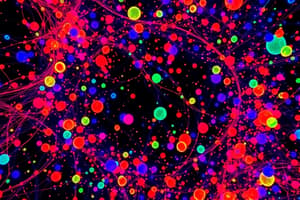Podcast
Questions and Answers
What type of light source is typically used in flow cytometry?
What type of light source is typically used in flow cytometry?
- Green laser
- Yellow laser
- Blue or violet laser (correct)
- Red laser
How are scattered light and emitted fluorescence detected in flow cytometry?
How are scattered light and emitted fluorescence detected in flow cytometry?
- Detected by photodetectors (correct)
- Detected by electrodes
- Detected by microphones
- Detected by thermometers
What do the scatter patterns in flow cytometry reflect?
What do the scatter patterns in flow cytometry reflect?
- Size, granularity, and complexity of the particles (correct)
- Color of the particles
- Pressure of the particles
- Temperature of the particles
What do the fluorescence intensities in flow cytometry originate from?
What do the fluorescence intensities in flow cytometry originate from?
What is one of the applications of flow cytometry mentioned in the text?
What is one of the applications of flow cytometry mentioned in the text?
Which field utilizes flow cytometry to analyze blood components?
Which field utilizes flow cytometry to analyze blood components?
What does flow cytometry enable in the field of virology?
What does flow cytometry enable in the field of virology?
In which area is flow cytometry utilized to study molecular markers and characteristics of cancer cells?
In which area is flow cytometry utilized to study molecular markers and characteristics of cancer cells?
Which category involves the tracking of stem cell differentiation and gene expression in embryonic development using flow cytometry?
Which category involves the tracking of stem cell differentiation and gene expression in embryonic development using flow cytometry?
What does flow cytometry analyze in environmental studies?
What does flow cytometry analyze in environmental studies?
Flashcards are hidden until you start studying
Study Notes
Overview of Flow Cytometry: Principles and Applications
Flow cytometry, a powerful and versatile analytical technique, has become a vital tool in fields such as biology, medicine, and immunology. This article examines the principles and applications of flow cytometry, providing an in-depth understanding of this remarkable technology.
Principles
Flow cytometry depends on the interaction of light with particles suspended in a fluid stream. The process works as follows:
- Light source: A laser light source, typically a blue or violet laser, illuminates a small volume of fluid flowing through a narrow tube.
- Scatter and fluorescence detection: The scattered light (forward and side scatter) and emitted fluorescence (from dye-labeled molecules) are detected by photodetectors as individual particles (cells, beads, or other molecules) pass through the laser beam.
- Data analysis: The collected data on scattered light and fluorescence intensities are analyzed using specialized software to identify and characterize the particles based on their size, shape, and the expression of specific molecules.
The scatter patterns (forward scatter, side scatter, and other angles) reflect the size, granularity, and complexity of the particles, whereas the fluorescence originates from specific molecules, such as antibodies, lectins, or nucleic acid stains, labeled with fluorophores.
Applications
The versatility of flow cytometry makes it an invaluable tool for a range of applications:
- Immunology: Flow cytometry is used to study the immune system, particularly in understanding the characteristics and functions of immune cells such as T and B cells, natural killer cells, and monocytes.
- Hematology: The technique is widely employed to analyze blood components, including red and white blood cells, platelets, and their subpopulations.
- Virology: Flow cytometry enables the detection and quantification of virus particles and infected cells, as well as the analysis of viral proteins and antigens.
- Cancer research: Flow cytometry is used to study the molecular markers and characteristics of cancer cells, helping to diagnose, classify, and monitor cancer progression.
- Developmental biology: The technique allows the tracking of stem cell differentiation and the analysis of gene expression in embryonic development.
- Plant biology: Flow cytometry is utilized to study plant cell characteristics, such as cell cycle analysis and the presence of specific molecules.
- Environmental studies: The technique is used to analyze particles in water, soil, and air, including the presence of pollutants and pathogens.
Despite the immense potential of flow cytometry, there are also limitations, such as the requirement for specialized equipment, trained personnel, and potential cross-reactivity between fluorophores. Nonetheless, flow cytometry remains one of the most important techniques for characterizing and analyzing biological particles, providing valuable insights into various fields of science and medicine.
Studying That Suits You
Use AI to generate personalized quizzes and flashcards to suit your learning preferences.




